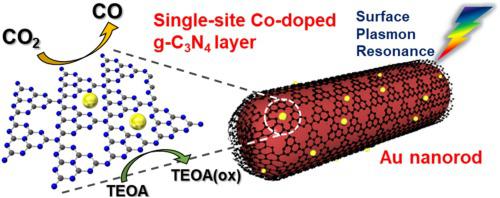Journal of CO2 Utilization ( IF 7.2 ) Pub Date : 2021-08-31 , DOI: 10.1016/j.jcou.2021.101691 Takeharu Yoshii 1 , Kenjirou Tamaki 1 , Yasutaka Kuwahara 1, 2, 3, 4 , Kohsuke Mori 1, 2, 3 , Hiromi Yamashita 1, 2, 3

|
Designing efficient photocatalyst materials for CO2 reduction and utilization has become important to address environmental and energy concerns. A new type of core–shell-structured nanocomposite catalyst is reported herein, in which single-site Co catalytic species are immobilized in graphitic carbon nitride (g-C3N4) layered on Au nanorods (NRs) for surface plasmon resonance (SPR)-enhanced photocatalytic CO2 conversion. Single-site Co species were incorporated into g-C3N4 via a simple pyrolysis process, and core–shell nanocomposites were self-formed via electrostatic interactions between the positively charged surfaces of the Au NRs and negatively charged single-site Co-coordinated g-C3N4 layer. The structure was comprehensively examined by TEM, XRD, UV–vis, Co K-edge XAFS, FT-IR, and zeta potential measurements, which showed that the g-C3N4 layer did not prevent the Au NRs from absorbing visible light. The nanocomposite efficiently catalyzed the reduction of CO2 to CO under visible light irradiation with the assistance of the SPR of the Au NRs. The catalytic activity of the core–shell-structured catalyst was superior to that of the corresponding aggregated catalyst, demonstrating that the formation of a core–shell structure affords efficient electron transport from the Au NRs to the catalytically active Co species.
中文翻译:

自组装核壳纳米复合催化剂由单中心配位 g-C3N4 和 Au 纳米棒组成,用于等离子体增强 CO2 还原
设计用于 CO 2还原和利用的高效光催化剂材料对于解决环境和能源问题变得很重要。本文报道了一种新型核壳结构纳米复合催化剂,其中单点 Co 催化物质固定在石墨氮化碳 (gC 3 N 4 ) 上,层状金纳米棒 (NRs) 用于表面等离子体共振 (SPR)-增强光催化CO 2转化。单点 Co 物种被纳入 gC 3 N 4通过简单的热解过程,核壳纳米复合材料是通过带正电的 Au NRs 表面和带负电的单点配位 gC 3 N 4层之间的静电相互作用自形成的。通过 TEM、XRD、UV-vis、Co K-edge XAFS、FT-IR 和 zeta 电位测量对结构进行了全面检查,结果表明 gC 3 N 4层不会阻止 Au NRs 吸收可见光。纳米复合材料有效催化 CO 2的还原在 Au NRs 的 SPR 的帮助下,在可见光照射下转化为 CO。核壳结构催化剂的催化活性优于相应的聚集催化剂,表明核壳结构的形成提供了从 Au NRs 到催化活性 Co 物种的有效电子传输。











































 京公网安备 11010802027423号
京公网安备 11010802027423号